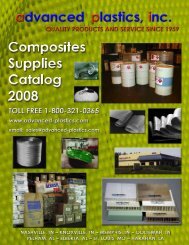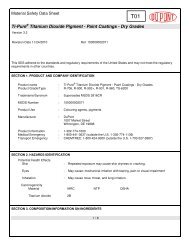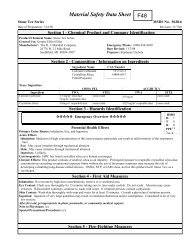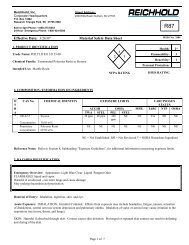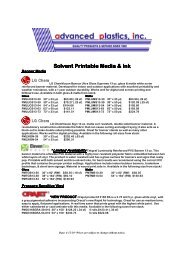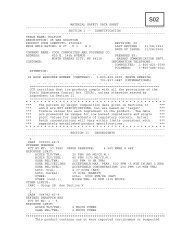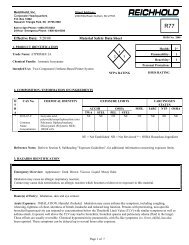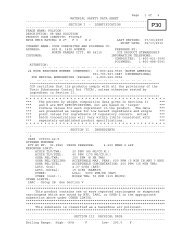Product Name: HONEY WAX 250 - Advanced Plastics
Product Name: HONEY WAX 250 - Advanced Plastics
Product Name: HONEY WAX 250 - Advanced Plastics
You also want an ePaper? Increase the reach of your titles
YUMPU automatically turns print PDFs into web optimized ePapers that Google loves.
<strong>Product</strong> <strong>Name</strong>: <strong>HONEY</strong> <strong>WAX</strong> <strong>250</strong><br />
Revision Date: 25 MAY 2011<br />
Page 1 of 5<br />
1. IDENTIFICATION OF THE SUBSTANCE/PREPARATION AND OF THE COMPANY/UNDERTAKING<br />
<strong>Product</strong> Code<br />
P52111, P52140<br />
<strong>Product</strong> <strong>Name</strong> Honey Wax ® <strong>250</strong><br />
Recommended Use<br />
Industrial Mold Release<br />
Manufacturer<br />
Specialty <strong>Product</strong>s Co Telephone Number: +1 951-479-0179<br />
1691 California Ave. Email Address: info@specialtyproductsco.com<br />
Corona, CA 92881 USA Emergency Phone Number: +1 703-527-3887 (CHEMTREC)<br />
+1 800 424-9300 in the US<br />
2. COMPOSITION/INFORMATION ON INGREDIENTS<br />
3. HAZARDS IDENTIFICATION<br />
Components CAS-No Percent by weight<br />
Mineral Spirits 8052-41-3 55-75<br />
HAZARDOUS IDENTIFICATION<br />
HMIS RATING/ NFPA<br />
Health: 1 Flammability: 2 Reactivity: 0 Protection: See Sec. 8<br />
VARIABILITY AMONG INDIVIDUALS<br />
Health studies have shown that many petroleum hydrocarbons and synthetic lubricants pose potential human health risks which<br />
may vary from person to person. As a precaution, exposure to liquids, vapors, mists, or fumes should be minimized.<br />
EFFECTS OF OVEREXPOSURE (Signs and symptoms of exposure)<br />
High vapor concentrations (greater than approximately 1000 ppm) are irritating to the eyes and the respiratory tract, and may<br />
cause headaches, dizziness, anesthesia, drowsiness, unconsciousness, and other central nervous system effects, including<br />
death.<br />
PRE-EXISTING MEDICAL CONDITIONS WHICH MAY BE AGGRAVATED BY EXPOSURE<br />
Petroleum Solvents/Petroleum Hydrocarbons - Skin contact may aggravate an existing dermatitis.<br />
CAUTION: FLAMMABLE SOLID. MAY CAUSE SKIN IRRITATION.<br />
Wash thoroughly after handling. Keep away from heat and flame.<br />
Potential Health Effects<br />
Eyes: Exposure is not expected to cause significant irritation.<br />
Skin: Prolonged skin contact may cause skin irritation and/or dermatitis. High standards of skin care and personal hygiene should<br />
be exercised at all times.<br />
Inhalation: Prolonged exposure through inhalation may cause damage to health.<br />
Ingestion: Ingestion may cause gastrointestinal irritation, nausea, vomiting, and diarrhea.<br />
Effect of overexposure: (Signs and symptoms of exposure)<br />
High vapor concentrations (greater than approximately 1000 ppm) are irritating to the eyes and the respiratory tract, and may<br />
cause headaches, dizziness, anesthesia, drowsiness, unconsciousness, and other central nervous system effects, including<br />
death.<br />
4. FIRST AID MEASURES<br />
General Advice If symptoms persist, call a physician. Show this safety data sheet to the doctor in attendance.<br />
Do not breathe vapors, mist, or gas.<br />
Eye Contact Immediately flush with plenty of water. After initial flushing, remove any contact lenses and continue flushing for at<br />
least 15 minutes. If symptoms persist, call a physician.<br />
Skin Contact Wash off immediately with soap and plenty of water removing all contaminated clothes and shoes. Consult a<br />
physician if necessary.<br />
Ingestion Call a physician immediately. Do NOT induce vomiting. Aspiration hazard if swallowed – can enter lungs and cause<br />
damage. Rinse mouth.<br />
Inhalation Not an expected route of exposure. Move to fresh air. Call a physician immediately. If breathing is irregular or stopped,<br />
administer artificial respiration. Avoid direct contact with skin. Use barrier to give mouth-to-mouth resuscitation.<br />
Notes to physician<br />
Treat symptomatically.
<strong>Product</strong> <strong>Name</strong>: <strong>HONEY</strong> <strong>WAX</strong> <strong>250</strong><br />
Revision Date: 25 MAY 2011<br />
Page 2 of 5<br />
Protection of First-aiders<br />
Use personal protective equipment. Remove all sources of ignition.<br />
5. FIRE-FIGHTING MEASURES<br />
Suitable Extinguishing Media Use Foam Carbon dioxide (CO2 ) Dry chemical Cool containers with flooding quantities of water<br />
until well after fire is out.<br />
Extinguishing Media Which Must not be Used for Safety Reasons Do not use a solid water stream as it may scatter and<br />
spread fire.<br />
Special exposure hazards arising from the substance or preparation itself, combustion products, resulting gases<br />
Flammable. May be ignited by heat, sparks, or flames. In the event of fire and/or explosion do not breathe fumes.<br />
Special Protective Equipment for Fire-fighters As in any fire, wear self-contained breathing apparatus pressure demand,<br />
MSHA/NIOSH (approved or equivalent) and full protective gear.<br />
6. ACCIDENTAL RELEASE MEASURES<br />
Environmental Precautions Prevent entry into waterways, sewers, basements or confined areas. Do not flush into surface water<br />
or sanitary sewer system.<br />
Personal Precautions Remove all sources of ignition. Use personal protective equipment. Ensure adequate ventilation. Take<br />
precautionary measures against static discharge.<br />
Methods for Cleaning Up Prevent product from entering drains. Contain spillage, and then collect with non-combustible<br />
absorbent material, (e.g. sand, earth, diatomaceous earth, vermiculite) and place in container for disposal according to local /<br />
national regulations (see section 13).<br />
Other Information See Section 12 for additional information<br />
7. HANDLING AND STORAGE<br />
Handling Keep away from open flames, hot surfaces and sources of ignition. Wash thoroughly after handling.<br />
Storage Keep container tightly closed in a cool, dry and well-ventilated place. Incompatible with oxidizing agents. Keep<br />
away from heat and sources of ignition.<br />
8. EXPOSURE CONTROLS / PERSONAL PROTECTION<br />
EXPOSURE LIMIT FOR NAPHTHA (PETROLEUM) HYDROTREATED HEAVY<br />
300 ppm (1800 mg/m3) for an 8-hour workday. Recommended by the manufacturer of the solvent.<br />
VENTILATION<br />
Use only with ventilation sufficient to prevent exceeding recommended exposure<br />
No smoking or use of flame or other ignition sources.<br />
PROTECTIVE GLOVES<br />
Use chemical-resistant gloves, if needed, to avoid prolonged or repeated skin contact<br />
EYE PROTECTION<br />
Use splash goggles when eye contact may occur.<br />
9. PHYSICAL AND CHEMICAL PROPERTIES<br />
General Information<br />
Physical State<br />
Odor<br />
Appearance<br />
Solid<br />
Aromatic<br />
Tan<br />
Important Health, Safety and Environmental Information<br />
Flash Point<br />
Boiling Point/Range<br />
pH<br />
Auto-ignition Temperature<br />
Vapor Pressure<br />
VOC Content<br />
Viscosity<br />
41 o C<br />
159-198°C<br />
Not applicable<br />
No information available<br />
No information available<br />
517-556 g/L<br />
No information available
<strong>Product</strong> <strong>Name</strong>: <strong>HONEY</strong> <strong>WAX</strong> <strong>250</strong><br />
Revision Date: 25 MAY 2011<br />
Page 3 of 5<br />
Solubility<br />
Soluble in hydrocarbons<br />
Water Solubility<br />
Negligible<br />
Evaporation Rate<br />
No information available<br />
Specific Gravity 0.797<br />
Flammability Limits in Air<br />
No information available<br />
Other Information<br />
Melting Point/Range 90°C<br />
10. STABILITY AND REACTIVITY<br />
Stability<br />
Conditions to Avoid<br />
Materials to Avoid<br />
Hazardous Decomposition <strong>Product</strong>s<br />
Stable under normal conditions<br />
Heat, flames, and sparks.<br />
Strong oxidizing agents.<br />
None under normal use<br />
11. TOXICOLOGICAL INFORMATION<br />
Acute Toxicity<br />
<strong>Product</strong> Information<br />
Inhalation<br />
Eye Contact<br />
Skin Contact<br />
Ingestion<br />
Chronic Toxicity<br />
Carcinogenicity<br />
No known effect based on information supplied.<br />
No known effect based on information supplied.<br />
Prolonged skin contact may de-fat the skin and produce dermatitis.<br />
Potential for aspiration if swallowed. Aspiration may cause pulmonary oedema and pneumonitis. The<br />
substance has delayed effects.<br />
Contains no ingredient listed as a carcinogen.<br />
NATURE OF HAZARD AND TOXICITY INFORMATION<br />
Prolonged or repeated skin contact with this product tends to remove skin oils, possibly leading to irritation and dermatitis;<br />
however, based on human experience and available toxicological data, this product is judged to be neither a "corrosive" nor an<br />
"irritant" by OSHA criteria.<br />
<strong>Product</strong> contacting the eyes may cause eye irritation.<br />
<strong>Product</strong> has a low order of acute oral and dermal toxicity, but minute amounts aspirated into the lungs during ingestion or vomiting<br />
may cause mild to severe pulmonary injury and possibly death.<br />
This product is judged to have an acute oral LD50 (rat) greater than 5 g/kg of body weight, and an acute dermal LD50 (rabbit)<br />
greater than 3.16 g/kg of body weight.<br />
The toxicity information is based on data available for Naphtha (Petroleum) Hydro-treated Heavy, a solvent component of the<br />
product.<br />
Data for Finished product is not available.<br />
12. ECOLOGICAL INFORMATION<br />
Ecotoxicity<br />
Harmful to aquatic organisms, may cause long-term adverse effects in the aquatic environment.<br />
Persistence and Degradability No information available<br />
Bioaccumulative Potential No information available<br />
Mobility<br />
No information available<br />
Do not discharge this product into public waters or waterways.<br />
Regulatory Requirements: Follow applicable OSHA regulations (29 CFR 1910.120).
<strong>Product</strong> <strong>Name</strong>: <strong>HONEY</strong> <strong>WAX</strong> <strong>250</strong><br />
Revision Date: 25 MAY 2011<br />
Page 4 of 5<br />
OSHA PEL ACGIH TLV NIOSH REL NIOSH<br />
Ingredient TWA STEL TWA STEL TWA STEL IDLH<br />
Isoparaffinic 500 ppm 500 ppm 500 ppm 500 ppm 500 ppm 500 ppm 1100 ppm<br />
Hydrocarbons<br />
Wax Blend None est. None est. None est. None est. None est. None est. None established<br />
13. DISPOSAL CONSIDERATIONS<br />
Disposal methods: Dispose of only in accordance with local, state, and federal regulations<br />
14. TRANSPORT INFORMATION<br />
U.S. DOT<br />
Transported by highway or rail:<br />
Non-bulk packagings (capacity less than or equal to 119 gallons)<br />
Not regulated<br />
Transported by air or marine vessel:<br />
Bulk or non-bulk packagings<br />
UN1325, Flammable solid, n.o.s., organic, (MINERAL SPIRITS) 4.1, III Ltd Quantity<br />
IMDG/IMO Proper Shipping <strong>Name</strong> Flammable solid, organic, n.o.s.<br />
Hazard Class 4.1<br />
UN-No<br />
Packing Group<br />
EmS<br />
Description<br />
UN1325<br />
III<br />
F-A, S-G<br />
UN1325, Flammable solid, organic, n.o.s. (Mineral Spirits), 4.1, PG III, LTD QTY<br />
RID Proper Shipping <strong>Name</strong> Flammable solid, organic, n.o.s.<br />
Hazard Class 4.1<br />
UN-No<br />
UN1325<br />
Packing Group<br />
III<br />
Classification Code F1<br />
Description<br />
UN1325, Flammable solid, organic, n.o.s. (Mineral Spirits) ,4.1,III,RID, LTD QTY<br />
ADR/RID-Labels 4.1<br />
ADR Proper Shipping <strong>Name</strong> Flammable solid, organic, n.o.s.<br />
Hazard Class 4.1<br />
UN-No<br />
UN1325<br />
Packing Group<br />
III<br />
Classification Code F1<br />
Description<br />
UN1325, Flammable solid, organic, n.o.s. (Mineral Spirits) ,4.1,III, LTD QTY<br />
ICAO UN-No UN1325<br />
Proper Shipping <strong>Name</strong> Flammable solid, organic, n.o.s.<br />
Hazard Class 4.1<br />
Packing Group<br />
III<br />
Description<br />
Flammable solid, organic, n.o.s.(Mineral Spirits),4.1,UN1325,PG III, LTD QTY<br />
IATA UN-No UN1325<br />
Proper Shipping <strong>Name</strong> Flammable solid, organic, n.o.s.<br />
Hazard Class 4.1<br />
Packing Group<br />
III<br />
ERG Code<br />
3L<br />
Description<br />
UN1325, Flammable solid, organic, n.o.s. (Mineral Spirits),4.1, PG III, LTD QTY<br />
15. REGULATORY INFORMATION
<strong>Product</strong> <strong>Name</strong>: <strong>HONEY</strong> <strong>WAX</strong> <strong>250</strong><br />
Revision Date: 25 MAY 2011<br />
Page 5 of 5<br />
International Inventories<br />
TSCA<br />
EINECS/ELINCS<br />
DSL/NDSL<br />
PICCS<br />
ENCS<br />
IECSC<br />
Complies<br />
Complies<br />
Complies<br />
AICS<br />
KECL<br />
Legend<br />
TSCA<br />
EINECS/ELINCS<br />
DSL/NDSL<br />
PICCS<br />
ENCS<br />
IECSC<br />
AICS<br />
KECL<br />
United States Toxic Substances Control Act Section 8(b) Inventory<br />
European Inventory of Existing Commercial Chemical Substances/EU List of Notified<br />
Chemical Substances<br />
Canadian Domestic Substances List/Non-Domestic Substances List<br />
Philippines Inventory of Chemicals and Chemical Substances<br />
Japan Existing and New Chemical Substances<br />
China Inventory of Existing Chemical Substances<br />
Australian Inventory of Chemical Substances<br />
Korean Existing and Evaluated Chemical Substances<br />
16. OTHER INFORMATION<br />
Prepared By<br />
SPECIALTY PRODUCTS CO.<br />
Issuing Date 25 MAY 2011<br />
Revision Note<br />
Not applicable<br />
Disclaimer<br />
The information provided on this SDS is correct to the best of our knowledge, information and belief at the date of its<br />
publication. The information given is designed only as a guide for safe handling, use, processing, storage,<br />
transportation, disposal and release and is not to be considered as a warranty or quality specification. The information<br />
relates only to the specific material designated and may not be valid for such material used in combination with any<br />
other material or in any process, unless specified in the text.





